Ann’s finally in a happy place after 22 years living with myeloma
Ann Bruce shares the story of her diagnosis, in her own words.
After years of chronic ill health and unable to reach full term with her pregnancies, it was a relief when Ann Bruce finally was diagnosed with myeloma, in May 1999. Her blood was dangerously thick, she had a high paraprotein level, and was given a life expectancy of six months. Ann was 45, living in regional South Australia and raising her young son largely on her own as her husband spent a lot of time interstate working. Despite his absences, he was her lifeline, but in 2006 he died in a tragic accident. Now aged 67, Ann tells her story as long-term myeloma survivor.
For quite a while, in my 30s, I never felt quite right. It’s hard to explain. I just didn’t seem to fit in. I was becoming vague – slow, disinterested, in a fog – but others didn’t notice as I have a bubbly personality.
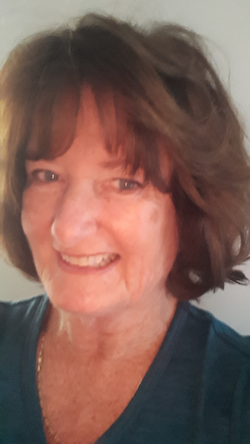
I met my wonderful husband, Graham, whilst in my late 30s. We lived at Mundalla, in south eastern South Australia and were businesspeople, running a couple of companies. Both of us wanted a family, but we were thrown a series of setbacks; miscarriages and two stillborn boys. Then, eventually, our tiny baby, Byron, was born by emergency caesarean at 26 weeks and weighing 680g, in March 1994.
For me it was a horrendous experience. I slipped in and out of consciousness, had terrible pain, and my healing was a very slow process, with a lack of energy and a general feeling of listlessness. This was put down to me being an older mum, at 40 years of age. Fortunately for my son, medical science kept prompting him to live and move forward.
That wasn’t the same for me. My recovery over the next two years was filled with constant antibiotics for one thing or another, while caring for a premature boy who was subject to seizures. My husband went back to work. We were shearing contractors working all over four states. Graham was a pilot who also was sitting for his commercial pilot licence, and I was manufacturing shearing dungas and work pants.
Both of us felt something with me was not right. My hair had become quite grey, my sight had become bad, and I was losing weight. And I was getting everything – a scratch would fester and become infected, a cough would need antibiotics and was followed by a sinus infection, at times I had pneumonia, ulcerative colitis, and I always had an upset stomach which made it difficult to eat lots of things. I was also having trouble lying down, as my heart was not happy in that position, so I slept sitting up. And my muscles would twitch constantly. That was quite draining to put up with.
A locum doctor came to our town who I saw when again I needed antibiotics. He asked, “what’s a woman like you doing with all these antibiotics”. I smiled and said, “I am just unlucky I guess”. He decided to take some blood and have a look. The next afternoon he rang me and, although a chill went over me, I was partially pleased he had found the problem. He asked me to see him immediately, but I wasn’t to drive, and where can we get your husband? Graham was in NSW at the time, controlling shearing teams. I needed to see a specialist in Adelaide who would explain to us both what it was that I had. Although happy something had finally surfaced, we had no idea what it was or how bad it was at that time. We had too many other things to deal with.
In Adelaide, the haematologist at the Royal Adelaide Hospital advised an immediate prep for an autologous stem cell transplant, as my life expectancy at that point was six months. But first, I was put on the apheresis machine to clean out the protein in my blood which was extremely thick. At that time my LgG protein was 67 g/L which was considered as the highest of high. The procedure was done again the next day and afterwards I noticed amazingly clear colours in everything, the sounds of people were crisper and clearer, and I could smell lots of things around me, so I was happy.
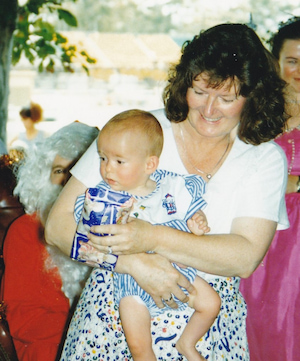
For the next six months I stayed in hospital, prepping for the transplant and this meant leaving my son and husband back in the country. During that time, I returned home briefly, to sort some belongings and find homes for all the animals. The house was cleared out with help from neighbours and it was eventually sold along with my business. My son, who was four years old, stayed on a farm in the care of our friends. Three months in, after having chemotherapy, my stem cells were harvested. My husband came to Adelaide to stay and help me with my treatment and the transplant. It was in October 1999 and I was told it would gain me three years and I remember thinking… three years would be wonderful.
My husband told me I did well with the transplant, so I was happy. I wasn’t one to attend to all the details of treatment at the time, so it was Graham, with his really good memory, who kept a firm eye on things and he would do the remembering for me.
It was getting close to the end of the year. After enduring all the treatment quite well, I just wanted to get out of hospital. I was discharged in the Christmas of 1999. My husband was offered a job in Western Australia, so off we went, arriving just in time for my son to start first grade. My husband was wonderful, but we knew he needed to get back to work, which was working away up in the north of WA as an agricultural pilot.
Shortly after we moved to WA, I was told to see a professor who would handle my myeloma from then, which we did. My myeloma was growing, it was coming back strong. I was a little taken back by being told I’d need another transplant within a couple of months – not likely, I thought – or to start on the only drug available for me at that time, which was interferon.
I took this drug home and carried on. I learned to like the injections as I was not about to sit through another transplant, and I got to understand the side effects of interferon. I was told to watch for depression at the time. Me being me, I needed to think of the future, so my husband would ring and talk to the specialist. I only needed Graham’s call saying, “you’ll live”, and that was good enough for me. I ensured that the interferon and me worked together, no matter what, we had to get along. The interferon not only stopped the growth of the myeloma, but every year it slowly receded.
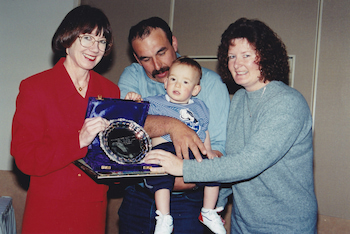
Graham and I had a plan. It was for Byron and me to manage without him, to allow my husband to advance in his career. Then, when he was at the top of his career, he would take a lot of time off to make up, and we would all be together, and my husband would be home to help with me and my son, and we don’t let go of plans.
For the next five years, Byron and I lived without my husband, basically, as he was always miles away following his career. In one way it made me strong, although I do remember days of utter desperation with very few people to call on. When things go wrong, I had to keep a brave face for my son… like everything is just fine.
When your lifeline is taken away, it makes you learn to swim instantly, sometimes with tears of desperation. It made me strong, it enabled me to make decisions about running a home, my son’s school commitments, my medication and illnesses. And it meant I had to act quickly. It made me see things through with or without tears, no matter how I felt, and to persevere.
At times I felt unable to see how I could find my way around and handle all the illnesses that would just crop up. A cold would become serious, and things would go wrong, requiring me to get to a hospital fairly fast. And when you are the ill one, it’s very hard to deal with yourself as, at the time, you are sick, exhausted, fatigued, upset… it all compounds and becomes a mountain. I was still very weak, and I kept my son isolated from it all, to maintain a normal, happy school scenario for him, one way or another. To me, always appearing normal and happy was paramount.
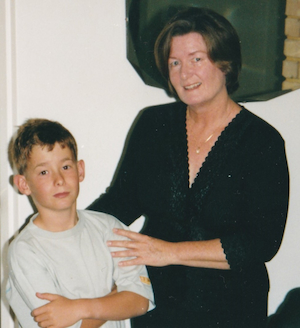
By 2006, I was beginning to gain more and more strength and felt good. My son and I had settled into the neighbourhood at Mandurah when the call came, “your husband has been killed in a dreadful accident”. That was the day when myeloma felt like nothing, of no consequence, a lot of everything about nothing. It was like someone had cut the cord on my spacesuit. I was totally and utterly adrift. I kept saying to myself, “someone’s made a terrible mistake, this is not right”.
Not understanding where my myeloma was at, and feeling that I could not make any smart decision for my son (then aged 11) and myself… where should I be, where am I to go, what’s best for my son, can I actually do anything mentally or physically, and how long will this next stage last?
Everything became surreal. We had gone without Graham – my husband and Byron’s father – for the good part of five years, but 2006 was the year Graham was coming home, to care for me and to give our son the attention he needed. He was qualified up in his profession and he just wanted to come home. To make matters worse, that year we didn’t have a work accident and sickness insurance policy.
I tried to get my son back to his routine as soon as possible. Kids are wonderfully resilient, and I am a great actor; that same smile and bubbly personality; it has always been my way of coping.
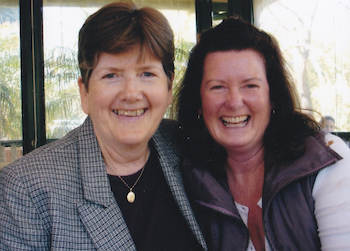
As I’ve said, my husband had always rung the specialist for me as I was not one who wanted to know. “You’ll live,” he would say, and that’s all I needed to know. That worked for me, that was how I coped. I just blocked it out. I was not about to give it any more time or energy or be negative. I was too busy working on the future, but consequently, after several months, I had to start dealing with myself again.
I am a tough character; it was up to me and there was only one way to go. I set out and walked the town and picked up a job in a settlement broker’s office which was a great distraction. I maintained a happy, fit-looking exterior, which was important, and the interferon made me run on my nerves. I decided to sell our home at Mandurah and return to Adelaide, just in time for my son to start high school, which was another great distraction. I found a peaceful place and settled into our home and Byron settled into school and enjoyed his teen years.
However, the interferon made me become isolated. I was unable to join in anything and anxiety was winding me up and controlling my movements and eventually my thoughts, and it was constantly putting me in hospital with heart issues that came and went. But it kept the myeloma at bay, so I felt I would just keep loving it.
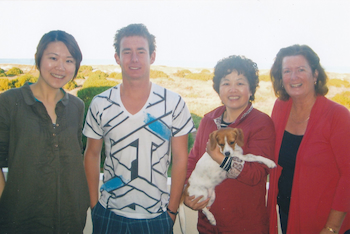
Three years on, I was having problems getting out of my car and my back was briefly painful taking the first few steps. A PET scan revealed multiple tumour activity in my lumbar spine which would need radiotherapy over a 30cm area, which I had, and which was brilliant… no more pain. Another three years on and my clavicle needed radiotherapy; another good fix. Two more years on and my breastbone needed radiotherapy. Clearly, the interferon was not holding the myeloma at bay anymore.
By 2016, the interferon had pushed me into a very bad place, and I crashed mentally. I had been on it for 15 years, and more and more the interferon was taking over and dishing out loads of anxiety, night and day. Finally, I could not control my thoughts or moods or my outbursts, which only my son knew about. I knew that only bad would come of it.
I had a hard time coming off the interferon. I would feel so bad, so I would start taking it again to calm my thoughts down. Eventually, as bad as it was, I needed to sit it out. Feeling devastated by my actions that my son, then aged 21, endured, I knew I had to leave him, to let him be around normal people, and for him to not see what was happening to me. I felt compelled to get away from everyone, so I left, and went to Queensland to see a girlfriend, leaving all my medication… out of my mind and out of my life. After a time, life became good for the first time in a long while and I forgot about myeloma.
It took approximately six months to resurface, and I remember being so angry with it. My son, in his sweet way, told me to come home to Adelaide to see a specialist, saying “it will be alright”, and I did. Treatment at the Queen Elizabeth Hospital started with thalidomide, then dexamethasone and thalidomide for a six-month period. Having bad neuropathy, I then moved on to a combination of bortezomib (Velcade®), dexamethasone, and cyclophosphamide for another six months. When the results weren’t good, I then moved to lenalidomide (Revlimid®) about five years ago. This has been good until just recently and is now topped up with dexamethasone, due to an active lesion. Apparently, I have another option to move to, so all is not lost.
The best thing is my mind is sharp, witty, and very active, maybe making up for it being dormant and out of control for so long. Today, I seek out complementary medicines and treatments and keep up-to-date on what’s around the corner for me.
For the last couple of years, I have actually felt more normal, and today I’m better and fitter than I was when I was diagnosed more than 20 years ago, when, at that time, I was very, very ill and I believe the myeloma had been brewing for around eight years. I am active, happy, grateful, and I keep a firm eye on my overall system.
It has, however, taken a toll on my son and I find it hard to communicate with him. He is reluctant to visit, although if I am in trouble he will always come around and pack a bag for the hospital and drop me off and I am always grateful for his help. He is the real hero in all of this. Byron is an electrician and he’s been working here in Adelaide but has just been offered a job in Western Australia. He leaves in a couple of months which is the next hurdle for us both to face. I am proud of him and I know he must find himself. And I will need to find the strength to move forward once again.
I have decided to sell my large home, to find a quieter lifestyle, and to be free to do some travelling and see as much as I can in safety and comfort. Taking the myeloma with me is not so much a problem as, generally, it remains hidden from most. When it needs me, I am well equipped and experienced to understand where I need to take it for some help. Life for me now is actually very, very good. I am happy.
Since my diagnosis, until now, aged 67, my regret is ‘never being normal’. I have always only had time to keep myself together and pretend to be normal for my son. My myeloma has taken me on an amazing, arduous, sometimes frightening journey. It has given me incredible resilience and a deeper understanding of life. I also know that keeping well is one thing, but being happy and having a plan for the future keeps me looking forward with a smile and a dream. There is never time to look back, and no point anyway.
These days, I long for walks in the hills or to just sit and admire the wonders of life amongst plants and trees. I am familiar with being alone, although now I also enjoy a good night out with girlfriends and do tend to be the rowdiest amongst them. I’m probably making up for lost time!
Although battle-scared, I am genuinely happy for my future and as usual, I have a plan – a nice comfortable home, not too big, with a fruit and vegetable garden, a feeling of being safe, involvement in the local community, and lovely areas to walk and explore. I am looking forward to a more in-control, peaceful and enjoyable life over the next 10 to 20 years. My future looks and feels pretty good.
If you have found any content in this story difficult or challenging, we encourage you to take care of your mental health and wellbeing, and to seek the advice of your treatment team if you have any questions regarding your diagnosis, treatment or side effects. If you would like more information, emotional and practical support, feel free to call 1800 620 420 to be connected to your local Leukaemia Foundation blood cancer support coordinator. Any mention of medical treatments is not an endorsement.